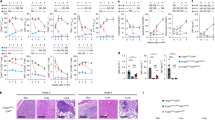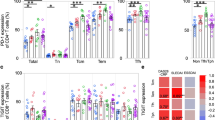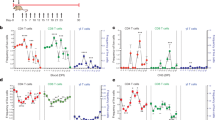Abstract
We demonstrate here the feasibility of antigen-specifically redirecting T cells against autoreactive T lymphocytes and thereby treating a model autoimmune disease. We created and transgenically expressed on T cells a heterodimeric chimeric receptor that genetically links an autoantigenic peptide, its restricting MHC, and the signal transduction domain of the T-cell receptor (TCR) ζ-chain. Engagement of the chimeric receptor by the TCR of autoreactive T cells activated the receptor-modified T cells in vitro and in vivo, inducing proliferation and cytolysis. Adoptively transferred receptor-modified T cells prevented and treated a model autoimmune disease, experimental allergic encephalomyelitis (EAE), even after epitope spreading had diversified the autoantigenic response. Treatment reduced disease severity and increased survival of affected animals, and was durable for >75 days. The receptor-modified cells acted both by strongly attenuating T-cell response to autoantigen as well as by shifting the residual response from an immunopathologic Th1 to a protective Th2 format.
This is a preview of subscription content, access via your institution
Access options
Subscribe to this journal
Receive 12 print issues and online access
$209.00 per year
only $17.42 per issue
Buy this article
- Purchase on Springer Link
- Instant access to full article PDF
Prices may be subject to local taxes which are calculated during checkout






Similar content being viewed by others
References
Zamvil, S.S. & Steinman, L. The T lymphocyte in experimental allergic encephalomyelitis. Annu. Rev. Immunol. 8, 579–621 (1990).
Green, E.A. & Flavell, R.A. The initiation of autoimmune diabetes. Curr. Opin. Immunol. 11, 663–669 (1999).
Weyand, C.M. & Goronzy, J.J. T-cell responses in rheumatoid arthritis: systemic abnormalities–local disease. Curr. Opin. Rheumatol. 11, 210–217 (1999).
Taneja, V. & David, C.S. HLA class II transgenic mice as models of human diseases. Immunol. Rev. 169, 67–79 (1999).
Heslop, H.E. & Rooney, C.M. Adoptive cellular immunotherapy for EBV lymphoproliferative disease. Immunol. Rev. 157, 217–222 (1997).
Mitsuyasu, R.T. et al. Prolonged survival and tissue trafficking following adoptive transfer of CD4-ζ gene-modified autologous CD4+ and CD8+ T cells in human immunodeficiency virus-infected subjects. Blood 96, 785–793 (2000).
Geiger, T.L. & Jyothi, M.D. Development and application of receptor-modified T lymphocytes for adoptive immunotherapy. Transfus. Med. Rev. 15, 21–34 (2001).
Romeo, C. & Seed, B. Cellular immunity to HIV activated by CD4 fused to T-cell receptor polypeptides. Cell 64, 1037–1046 (1991).
Irving, B. & Weiss, A. The cytoplasmic domain of the T-cell receptor ζ-chain is sufficient to couple to receptor-associated signal transduction pathways. Cell 64, 891–901 (1991).
Eshhar, Z. Tumor-specific T-bodies: towards clinical application. Cancer Immunol. Immunother. 45, 131–136 (1997).
Maher, J., Brentjens, R.J., Gunset, G., Riviere, I. & Sadelain, M. Human T-lymphocyte cytotoxicity and proliferation directed by a single chimeric TCR-ζ/CD28 receptor. Nat. Biotechnol. 20, 70–75 (2002).
Kono, D. et al. Two minor determinants of myelin basic protein induce experimental allergic encephalomyelitis in SJL/J mice. J. Exp. Med. 168, 213–227 (1988).
Kozono, K., White, J., Clements, J., Marrack, P. & Kappler, J. Production of soluble class II proteins with covalently bound single peptides. Nature 369, 151–154 (1994).
Sakai, K. et al. Characterization of a major encephalitogenic T-cell epitope in SJL/J mice with synthetic oligopeptides of myelin basic protein. J. Neuroimmunol. 19, 21–32 (1988).
Greaves, D., Wilson, F., Lang, G. & Kioussis, D. Human CD2 3′-flanking sequences confer high-level, T cell-specific, position-independent gene expression in transgenic mice. Cell 56, 979–986 (1989).
Festenstein, R. et al. Locus control region function and heterochromatin-induced position effect variation. Science 271, 1123–1125 (1996).
Geiger, T., Leitenberg, D. & Flavell, R. The T-cell-receptor ζ-chain is sufficient for the activation and maturation of primary T lymphocytes. J. Immunol. 162, 5931–5939 (1999).
Martin, R. & McFarland, H. Immunological aspects of experimental allergic encephalomyelitis and multiple sclerosis. Crit. Rev. Clin. Lab. Sci. 32, 121–182 (1995).
Vanderlugt, C.L. & Miller, S.D. Epitope spreading in immune-mediated diseases: implications for immunotherapy. Nat. Rev. Immunol. 2, 85–95 (2002).
Garren, H. et al. Combination of gene delivery and DNA vaccination to protect from and reverse Th1 autoimmune disease via deviation to the Th2 pathway. Immunity 15, 15–22 (2001).
Tarner, I.H. & Fathman, C.G. Gene therapy in autoimmune disease. Curr. Opin. Immunol. 13, 676–682 (2001).
Jiang, H. et al. T-cell vaccination induces T-cell receptor Vβ-specific Qa-1-restricted regulatory CD8+ T cells. Proc. Natl. Acad. Sci. USA 95, 4533–4537 (1998).
Vandenbark, A.A., Hashim, G. & Offner, H. Immunization with a synthetic T-cell receptor V-region peptide protects against experimental autoimmune encephalomyelitis. Nature 341, 541–544 (1989).
Sun, D., Whitaker, J.N. & Wilson, D.B. Regulatory T cells in experimental allergic encephalomyelitis. I. Frequency and specificity analysis in normal and immune rats of a T-cell subset that inhibits disease. Int. Immunol. 11, 307–315 (1999).
Willenborg, D.O., Fordham, S.A., Staykova, M.A., Ramshaw, I.A. & Cowden, W.B. IFN-γ is critical to the control of murine autoimmune encephalomyelitis and regulates both in the periphery and in the target tissue: a possible role for nitric oxide. J. Immunol. 163, 5278–5286 (1999).
Fink, P.J., Shimonkevtz, R.P. & Bevan, M.J. Veto cells. Ann. Rev. Immunol. 6, 115–137 (1988).
Reich-Zeliger, S., Zhao, Y., Krauthgamer, R., Bachar-Lustig, E. & Reisner, Y. Anti-third party CD8+ CTLs as potent veto cells: coexpression of CD8 and FasL is a prerequisite. Immunity 13, 507–515 (2000).
Das, M.P., Nicholson, L.B., Greer, J.M. & Kuchroo, V.K. Autopathogenic T-helper cell type 1 (Th1) and protective Th2 clones differ in their recognition of the autoantigenic peptide of myelin proteolipid protein. J. Exp. Med. 186, 867–876 (1997).
Falcone, M. & Bloom, B.R. A T-helper cell 2 (Th2) immune response against non-self antigens modifies the cytokine profile of autoimmune T cells and protects against experimental allergic encephalomyelitis. J. Exp. Med. 185, 901–907 (1997).
Jiang, H., Braunstein, N.S., Yu, B., Winchester, R. & Chess, L. CD8+ T cells control the TH phenotype of MBP-reactive CD4+ T cells in EAE mice. Proc. Natl. Acad. Sci. USA 98, 6301–6306 (2001).
Coligan, J., Kruisbeek, A., Margulies, D., Shevach, E. & Strober, W. Current Protocols in Immunology (John Wiley and Sons, New York, 1994).
Sheehy, M.E., McDermott, A.B., Furlan, S.N., Klenerman, P. & Nixon, D.F. A novel technique for the fluorometric assessment of T-lymphocyte antigen-specific lysis. J. Immunol. Methods 249, 99–110 (2001).
Gaur, A. et al. Amelioration of relapsing experimental autoimmune encephalomyelitis with altered myelin basic protein peptides involves different cellular mechanisms. J. Neuroimmunol. 74, 149–158 (1997).
Acknowledgements
The authors thank Richard Cross, Dick Ashmun, and Mahnaz Paktinat for assistance with flow cytometry and cell sorting, Phuong Nguyen for assistance with mouse phenotyping, and D. Kioussis for providing the phCD2-VA expression vector. This work is supported by NIH grants AI01480 and AI49872 (T.L.G.), the American Lebanese Syrian Associated Charities (T.L.G., M.D.J.), and the Howard Hughes Medical Institute (R.A.F.).
Author information
Authors and Affiliations
Corresponding author
Ethics declarations
Competing interests
The authors declare no competing financial interests.
Rights and permissions
About this article
Cite this article
Jyothi, M., Flavell, R. & Geiger, T. Targeting autoantigen-specific T cells and suppression of autoimmune encephalomyelitis with receptor-modified T lymphocytes. Nat Biotechnol 20, 1215–1220 (2002). https://doi.org/10.1038/nbt758
Received:
Accepted:
Published:
Issue Date:
DOI: https://doi.org/10.1038/nbt758
This article is cited by
-
Therapeutic efficacy of anti-CD19 CAR-T cells in a mouse model of systemic lupus erythematosus
Cellular & Molecular Immunology (2021)
-
Polymorphic estrogen receptor binding site causes Cd2-dependent sex bias in the susceptibility to autoimmune diseases
Nature Communications (2021)
-
Deciphering CD4+ T cell specificity using novel MHC–TCR chimeric receptors
Nature Immunology (2019)
-
Can the immune system be harnessed to repair the CNS?
Nature Reviews Neuroscience (2008)
-
Prevention and treatment of experimental autoimmune encephalomyelitis with recombinant adeno-associated virus-mediated α-melanocyte-stimulating hormone-transduced PLP139-151-specific T cells
Gene Therapy (2007)



